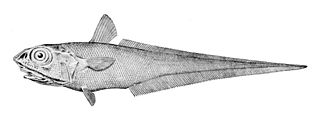
Grenadiers or rattails are generally large, brown to black gadiform marine fish of the subfamily Macrourinae, the largest subfamily of the family Macrouridae. Found at great depths from the Arctic to Antarctic, members of this subfamily are amongst the most abundant of the deep-sea fish.

Macrouridae is a family of deep sea fish, a diverse and ecologically important group, which are part of the order of cod-like fish, the Gadiformes. The species in the Macrouridae are characterised by their large heads which normally have a single barbel on the chin, projecting snouts, and slender bodies that taper to whip-like tails, without an obvious caudal fin but what there is of the caudal fin is often confluent with the posterior dorsal and anal fins. There are normally two dorsal fins, the anterior dorsal fin is quite high, the posterior quite low but is longer and takes up a greater proportion of the fish's of the back, species in the subfamily Macrouroidinae have a single dorsal fin. The long anal fin is almost as long as the second dorsal fin is nearly as long as the posterior dorsal, and sometimes it is longer. The pelvic fin is inserted in the vicinity of the thorax and normally has 5-17 fin rays but are absent in Macrouroides. The body is covered in small scales and if they have a photophore, it is usually on the midline of the abdomen just in front of the anus. The bioluminescence of these fish is produced by symbiotic bioluminescent bacteria. The structure of the skull has been used to show their placing in the Gadiformes, but they differ from the typical cods in that they possess one stout spine in the anterior dorsal fin.

Epinephelus is a genus of marine ray-finned fish, groupers from the subfamily Epinephelinae, part of the family Serranidae, which also includes the anthias and sea basses. They are predatory fish, largely associated with reefs and are found in tropical and subtropical seas throughout the world. They are important target species for fisheries.

The ridge scaled rattail or ridge-scaled grenadier, Macrourus carinatus, is a species of deep-water fish in the family Macrouridae. It has southern circumglobal distribution in temperate to subantarctic waters (34°S–65°S) and is found in the Southern Atlantic, Indian and Pacific Oceans and in the Southern Ocean at depths of about 200–1,200 m (660–3,940 ft).

Coelorinchus is a genus of rattail fish.

Coryphaenoides is a genus of rattails which is found in all oceans of the world. They are found in deep waters and C. yaquinae, recorded to 7,012 m (23,005 ft), is the only member in the family known from the hadal zone.

Lucigadus is a genus of rattails.

Nezumia is a genus of rattails. The generic name derives from the Japanese 鼠 (nezumi), meaning "mouse".

Gadomus colletti is a species of rattail. This deep-water fish is found in the waters around Japan, the Philippines, and northern Taiwan.
The unicorn grenadier, Coelorinchus productus, is a species of rattail. This fish is found at depths of up to 600 metres (2,000 ft) in the waters around northern Taiwan, southern Japan and the East China Sea.

Hymenocephalus is a genus of rattails.

Hymenogadus gracilis, also known as the Graceful grenadier is a species of rattail fish. It is found at depths of 160–345 m (525–1,132 ft) in tropical and subtropical seas worldwide. This is one of the smallest of the rattails, growing to no more than 13 cm (5.1 in) in length. It is a slender fish with a large mouth, with rows of very small teeth, positioned in the underside of the skull. There is a short, thin chin barbel. It is more strikingly marked than most rattails, with bold black streaks on the head and black and silver barring over most of the body. There is a long bioluminescent organ with two lenses underneath the rear end of the body.
The arrowtooth grenadier is a species of rattail. This is a deep-water fish found at depths of up to 950 m. It was originally recorded from the waters around Hawaii but has recently also been recorded near Taiwan, which suggests it has a far wider distribution than previously thought.
Ventrifossa saikaiensis is a species of rattail. This is a deep-water fish found at depths of up to 740 m. It is found in the waters off southern Japan and northeastern Taiwan.

Lutjanus is a genus of marine ray-finned fish, snappers belonging to the family Lutjanidae. They are found in the Atlantic, Indian, and Pacific Oceans. They are predatory fish usually found in tropical and subtropical reefs, and mangrove forests. This genus also includes two species that only occur in fresh and brackish waters.

Coryphaenoides rupestris is a species of marine ray-finned fish in the family Macrouridae. Its common names include the rock grenadier, the roundnose grenadier and the roundhead rat-tail. In France it is known as grenadier de roche and in Spain as granadero de roca. It is a large, deep-water species and is fished commercially in the northern Atlantic Ocean.

Macrourus berglax, the roughhead grenadier or onion-eye grenadier, is a species of marine ray-finned fish in the family Macrouridae. It is a deep-water fish found in the Atlantic Ocean.

Cirrhitus is a genus of marine ray-finned fish, hawkfishes from the family Cirrhitidae. The species in this genus are found on tropical reefs worldwide.

Coelorinchus caribbaeus, the blackfin grenadier, is a member of the family Macrouridae. It is a marine benthopelagic rattail. It has a wide range in the western tropical Atlantic. It lives in depths of 200 meters to 700 meters

Trachyrincus scabrus, the roughsnout grenadier or Mediterranean longsnout grenadier, is a species of bathydemersal marine fish from the subfamily Trachyrincinae, part of the family Macrouridae. It is found in the eastern Atlantic Ocean and the Mediterranean.
















